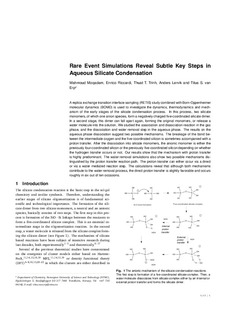| dc.contributor.author | Moqadam, Mahmoud | |
| dc.contributor.author | Riccardi, Enrico | |
| dc.contributor.author | Trinh, Thuat | |
| dc.contributor.author | Lervik, Anders | |
| dc.contributor.author | van Erp, Titus Sebastiaan | |
| dc.date.accessioned | 2018-06-28T08:49:56Z | |
| dc.date.available | 2018-06-28T08:49:56Z | |
| dc.date.created | 2017-09-07T12:44:44Z | |
| dc.date.issued | 2017 | |
| dc.identifier.citation | Physical Chemistry, Chemical Physics - PCCP. 2017, 19 (20), 13361-13371. | nb_NO |
| dc.identifier.issn | 1463-9076 | |
| dc.identifier.uri | http://hdl.handle.net/11250/2503493 | |
| dc.description.abstract | A replica exchange transition interface sampling (RETIS) study combined with Born-Oppenheimer molecular dynamics (BOMD) is used to investigate the dynamics, thermodynamics and mechanism of the early stages of the silicate condensation process. In this process, two silicate monomers, of which one anion species, form a negatively charged five-coordinated silicate dimer. In a second stage, this dimer can fall apart again, forming the original monomers, or release a water molecule into the solution. We studied the association and dissociation reaction in the gas phase, and the dissociation and water removal step in the aqueous phase. The results on the aqueous phase dissociation suggest two possible mechanisms. The breakage of the bond between the intermediate oxygen and the five-coordinated silicon is sometimes accompanied with a proton transfer. After the dissociation into silicate monomers, the anionic monomer is either the previously four-coordinated silicon or the previously five-coordinated silicon depending on whether the hydrogen transfer occurs or not. Our results show that the mechanism with proton transfer is highly predominant. The water removal simulations also show two possible mechanisms distinguished by the proton transfer reaction path. The proton transfer can either occur via a direct or via a water mediated reaction step. The calculations reveal that although both mechanisms contribute to the water removal process, the direct proton transfer is slightly favorable and occurs roughly in six out of ten occasions. This is the first time ever that the RETIS approach is applied in combination with Ab Initio molecular dynamics. In this study, we revealed some crucial mechanistic steps in the process of silica oligomerization which would not be possible to detect by any other method as they tend to disrupt the spontaneous dynamics of the system. | nb_NO |
| dc.language.iso | eng | nb_NO |
| dc.publisher | Royal Society of Chemistry | nb_NO |
| dc.title | Rare event simulations reveal subtle key steps in aqueous silicate condensation | nb_NO |
| dc.type | Journal article | nb_NO |
| dc.type | Peer reviewed | nb_NO |
| dc.description.version | acceptedVersion | nb_NO |
| dc.source.pagenumber | 13361-13371 | nb_NO |
| dc.source.volume | 19 | nb_NO |
| dc.source.journal | Physical Chemistry, Chemical Physics - PCCP | nb_NO |
| dc.source.issue | 20 | nb_NO |
| dc.identifier.doi | 10.1039/C7CP01268C | |
| dc.identifier.cristin | 1491702 | |
| dc.relation.project | Norges forskningsråd: 237423 | nb_NO |
| dc.description.localcode | © 2017. This is the authors' accepted and refereed manuscript to the article. The final authenticated version is available online at: http://dx.doi.org/10.1039/C7CP01268C | nb_NO |
| cristin.unitcode | 194,66,25,0 | |
| cristin.unitcode | 194,64,91,0 | |
| cristin.unitname | Institutt for kjemi | |
| cristin.unitname | Institutt for bygg- og miljøteknikk | |
| cristin.ispublished | true | |
| cristin.fulltext | preprint | |
| cristin.qualitycode | 2 | |
